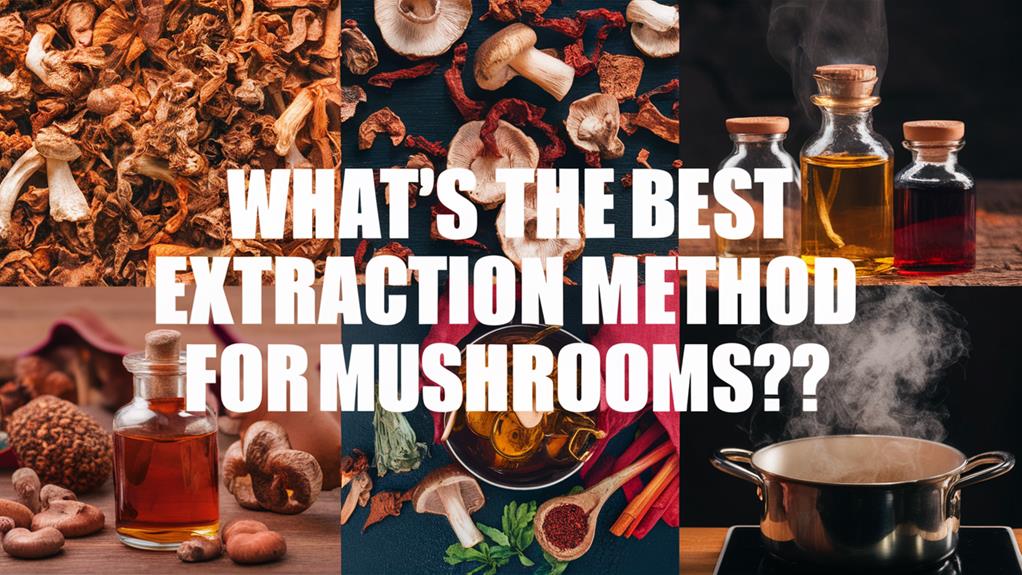
The best extraction method for mushrooms often combines hot water and alcohol in a dual extraction technique. This approach captures both water-soluble compounds, like polysaccharides, and non-water-soluble compounds, such as triterpenes. It maximizes the health benefits from medicinal mushrooms, ensuring you get the full spectrum of bioactive compounds. While hot water extraction is simple and effective for many, alcohol extraction enhances bioavailability and is particularly efficient for certain components. Using a dual method helps you unlock a richer tincture, giving you a more potent extraction. Stick around to uncover practical tips and methods for improving your mushroom extractions!
Overview of Extraction Methods
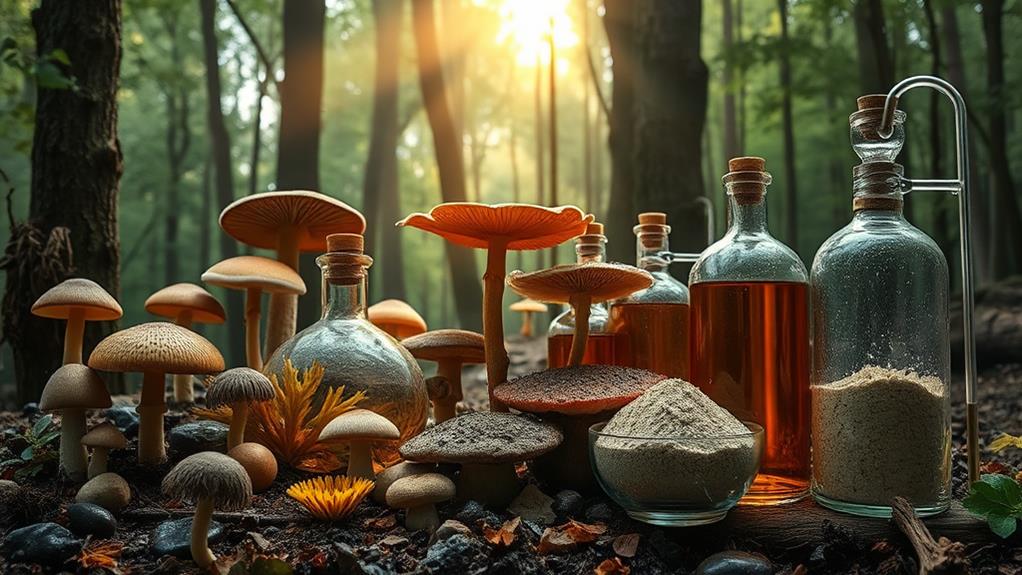
When it comes to extracting compounds from mushrooms, several methods stand out for their effectiveness. One popular technique is hot water extraction, which focuses on isolating water-soluble compounds like polysaccharides. This method works well for many medicinal mushrooms, as it captures essential bioactive compounds that can provide health benefits, particularly for gut health and immune function support water-soluble compounds.
Another approach is dual extraction. This combines both hot water and alcohol to maximize the extraction of various bioactive compounds. By using this method, you can effectively target both hydrophilic and non-water-soluble compounds, such as triterpenes and flavonoids. Sequential solvent extraction often begins with hot water, followed by ethanol, allowing you to optimize the yield and quality of your extracts.
Emerging technologies like ultrasound and microwave-assisted extraction are also gaining attention. These methods enhance traditional extraction processes, improving compound yield and efficiency.
However, the effectiveness of these techniques can vary significantly based on factors like solvent type, temperature, and extraction time. This highlights the importance of optimized protocols in research to ensure you get the best results from your mushroom extracts. Understanding these methods will help you choose the right one for your needs.
Alcohol Extraction Benefits
Alcohol extraction offers significant advantages for maximizing the health benefits of mushrooms. This method efficiently isolates non-water-soluble medicinal compounds, like triterpenes and phenolic acids, which are often crucial for your well-being.
Additionally, properly grinding dried mushrooms before extraction can further enhance the efficiency of this process, ensuring you get the most out of the mushroom's compounds. By focusing on these compounds, alcohol extraction allows you to tap into the therapeutic properties of mushrooms, resulting in effective tinctures that retain high concentrations of active constituents. This process is particularly important for mushrooms like Reishi and Chaga, which are known for their potent health benefits, including immune support.
Using a high-proof alcohol, such as 190 proof Everclear, enhances the extraction process. It draws out beneficial compounds like ganoderic acids found in Reishi mushrooms.
While alcohol extraction effectively targets these specific compounds, it can also be combined with water extraction in a dual extraction method. This approach maximizes the yield of bioactive compounds, providing you with a more comprehensive profile of both soluble and insoluble elements.
Research shows that alcohol extraction significantly improves the bioavailability of these compounds, making them easier for your body to absorb and utilize.
Water Extraction Advantages
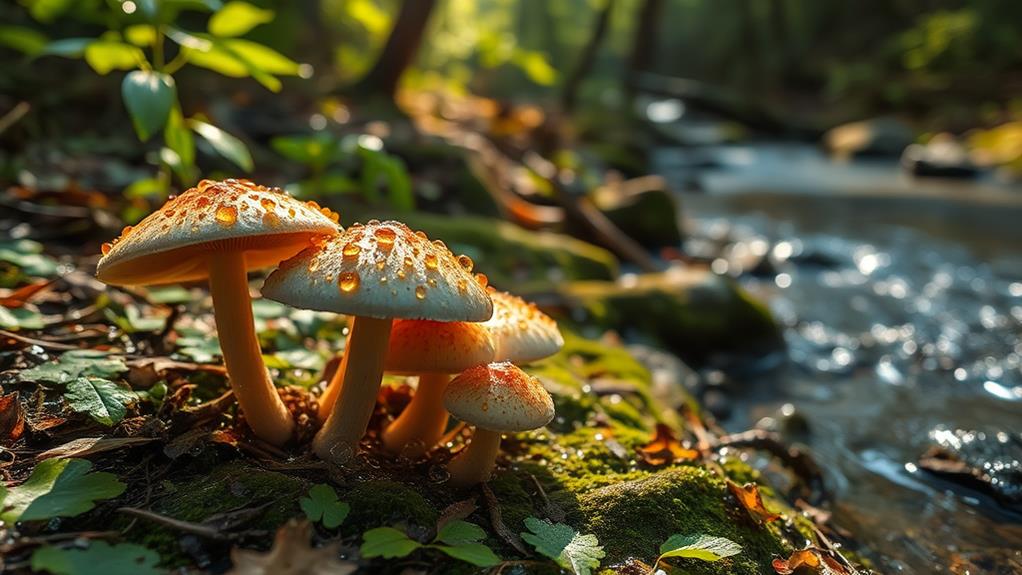
When you choose water extraction for mushrooms, you unlock enhanced nutrient bioavailability, making the beneficial compounds more accessible to your body.
This method is also incredibly simple, resembling the way you brew tea, where hot water gently extracts valuable nutrients while leaving behind unwanted solids.
By utilizing hot water extraction, you can effectively isolate water-soluble polysaccharides, which are known for their immune-boosting properties, such as those found in Turkey Tail.
With just a few steps, you can enjoy all the immune-boosting properties mushrooms have to offer.
Enhanced Nutrient Bioavailability
Water extraction offers remarkable advantages for enhancing nutrient bioavailability in mushrooms. This method effectively releases water-soluble compounds like polysaccharides and beta-glucans, which are celebrated for their immune-boosting properties.
When you use hot water extraction, it mimics the brewing process of tea, breaking down the tough chitinous cell walls of mushrooms. This action allows beneficial compounds to become more accessible, improving their bioavailability.
Research shows that using acidic water can yield even higher efficiencies for polyphenolic compounds, essential for antioxidant activity and overall health. For instance, mushrooms such as Turkey Tail and Lion's Mane benefit greatly from this extraction method, making the medicinal properties of these fungi easier for your body to absorb.
Moreover, studies indicate that proper hot water extraction preserves a significant amount of antioxidant capacity. For example, mushrooms like Boletus edulis display impressive radical scavenging activity when extracted with hot water.
Simple Preparation Process
There's something refreshing about how simple the water extraction process is for mushrooms. This method allows you to easily isolate water-soluble compounds like polysaccharides and beta-glucans, which are known for their impressive health benefits. By mimicking traditional tea brewing, you can cook raw mushroom materials in hot water for a set period, helping to release all those beneficial compounds.
Hot water extraction is especially popular because it yields a high concentration of antioxidants, which can support your immune health and overall wellness. Plus, it's a method that anyone can try at home with minimal equipment. You don't need fancy gadgets or skills—just some mushrooms and water will do.
Studies show that aqueous extracts often have a higher total phenolic content and greater antioxidant activity than those obtained through other solvents. This means that when you use the water extraction process, you're likely getting more of the good stuff that mushrooms have to offer.
Comparing Extraction Efficiency
When you're looking to extract the most from mushrooms, your choice of solvent can make a big difference.
Using a single solvent might work for some compounds, but combining solvents, like hot water and ethanol, often gives you better results.
Understanding the strengths of each method helps you maximize the extraction efficiency and unlock the full potential of the bioactive compounds in mushrooms.
Extraction Solvent Selection
Choosing the right extraction solvent is crucial for maximizing the yield and quality of bioactive compounds from mushrooms. The extraction solvents you use significantly affect the results. Water and ethanol are common choices, each targeting different compounds. Ethanol is great for medium polarity compounds like phenols and flavonoids, while water effectively extracts water-soluble compounds such as polysaccharides and beta-glucans.
If you're aiming for the best results, consider using a sequential extraction method. Start with ethanol to break down water-insoluble bonds, then follow up with water for a more efficient extraction of mushroom material. This approach often enhances the total yield of bioactive compounds.
Different extraction orders can influence the total phenolic content (TPC) and antioxidant capacity (TEAC) of your mushroom extracts. Studies show that aqueous extracts usually perform better in these areas compared to hydro-alcoholic or etheric extracts.
Dual vs. Single Extraction
In the realm of mushroom extraction, understanding the differences between dual and single extraction methods can significantly impact the efficiency of bioactive compound recovery.
Dual extraction combines hot water and ethanol methods, allowing you to extract both water-soluble beta-glucans and non-water-soluble triterpenes. This combination maximizes the overall yield and efficacy of the extracts.
On the other hand, single extraction focuses on one solvent at a time. Hot water extraction mainly targets polysaccharides, while ethanol extraction pulls out phenolic compounds. This means you might miss out on important bioactive compounds by using just one method.
Research shows that dual extraction is especially useful for mushrooms like Chaga and Reishi, which contain substantial non-water-soluble compounds. By using both solvents, you're more likely to get the full spectrum of health benefits these mushrooms offer.
Ultimately, the choice between dual and single extraction should depend on the specific benefits you're looking for. If a mushroom lacks significant non-water-soluble compounds, single extraction might suffice.
However, for a comprehensive approach, dual extraction often proves to be more effective.
Dual Extraction Techniques
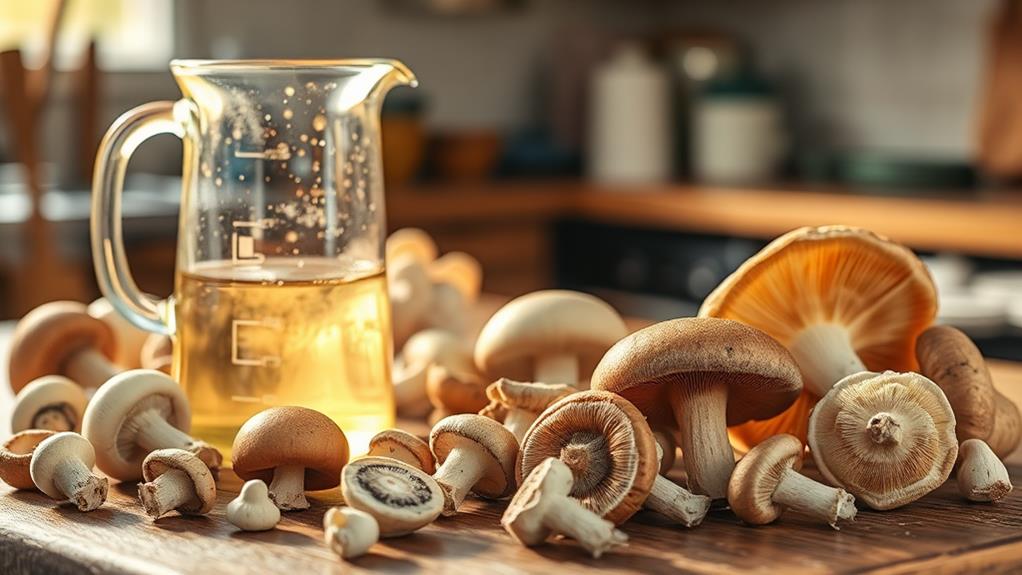
Dual extraction techniques offer a powerful way to harness the full potential of medicinal mushrooms. This method involves using both hot water and alcohol to maximize mushroom extraction, targeting both water-soluble and non-water-soluble bioactive compounds.
You start the process with a hot water extraction, which captures beneficial water-soluble compounds like beta-glucans. After that, you soak the remaining solids in alcohol to extract non-water-soluble constituents, such as triterpenes.
This technique is particularly effective for mushrooms like Reishi and Chaga, which are rich in both types of compounds. Research shows that dual extraction can produce a more comprehensive tincture, enhancing the overall health benefits associated with these mushrooms.
You'll find that the final product of dual extraction is often a liquid that combines the strengths of both methods, resulting in a tincture filled with a diverse array of beneficial compounds.
Solvent-Specific Bioactive Compounds
The extraction method you use can significantly influence the bioactive compounds you obtain from mushrooms. When you perform extraction with water, you often find that aqueous extracts yield higher total phenolic content (TPC) and better antioxidant activity. This is especially true when using acidic water, like a 10% acetic acid solution, which excels at extracting polyphenolic compounds.
However, not all mushrooms respond the same way to different solvents. Each mushroom species has unique bioactive compounds that might require specific solvents for optimal extraction. For instance, if you're aiming to extract non-water-soluble compounds like flavonoids and triterpenes, using ethanol in a mixed solvent system is your best bet.
Additionally, the order in which you apply solvents can change your results. Starting with high-percentage ethanol can soften water-insoluble materials, making your subsequent extraction with water much more effective.
Factors Influencing Extraction Quality
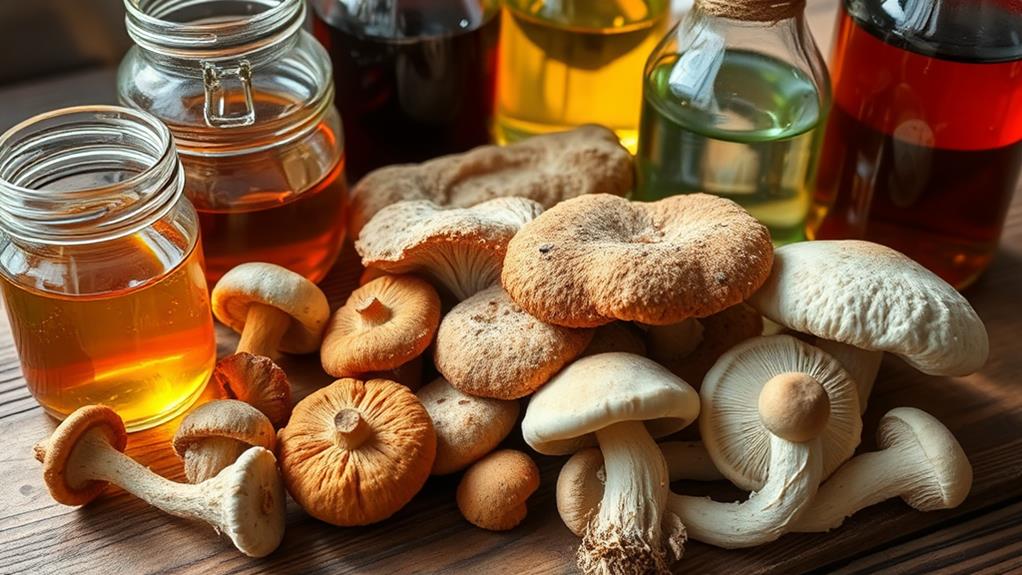
When extracting bioactive compounds from mushrooms, several key factors can significantly influence the quality of your results. Understanding these factors can help you achieve optimal extraction quality.
- Solvent Type: The solvent you choose plays a crucial role. Acidic water often yields the best results for polyphenolic compounds, while ethanol is better for medium-polarity compounds like phenols.
- Extraction Temperature: The temperature at which you extract can affect the efficiency of the process. Higher temperatures may increase yields, but they can also degrade sensitive compounds.
- Standardized Practices: Consistency is vital. Inconsistencies in extraction methodologies can lead to varying results, so following standardized practices is essential for reproducibility.
It's also important to note that the order in which you apply solvents can enhance extraction. For instance, using ethanol first might help break down water-insoluble bonds, making subsequent water extraction more effective.
Lastly, always consider the extraction duration and specific goals to optimize your results. By paying attention to these factors, you'll improve your chances of getting high-quality mushroom extracts.
Practical Tips for Extraction
To achieve high-quality mushroom extracts, applying practical tips during the extraction process makes a significant difference. Start by utilizing dual extraction methods that combine hot water and alcohol. This approach helps you maximize the extraction of both water-soluble compounds, like beta-glucans, and non-water-soluble compounds, such as triterpenes, found in mushrooms.
Ensure your mushrooms are thoroughly dried and ground. This increases the surface area, enhancing extraction efficiency and allowing better solvent penetration.
When you're performing hot water extraction, maintain consistent temperatures between 130-160°F. This helps effectively release the bioactive compounds in mushrooms without degrading them.
For harder mushrooms like chaga, use a sausage grinder or hatchet for initial grinding, followed by a coffee grinder for a fine powder. This thorough processing is essential for optimal results.
After extraction, strain the final tincture through fine cheesecloth or a nut-milk bag. This step is crucial for achieving clarity and quality, as it removes any undissolved solids, resulting in a smoother product.
Conclusion
In conclusion, choosing the right extraction method for mushrooms can significantly impact the quality of the compounds you get. For instance, studies show that alcohol extraction can yield up to 90% more bioactive compounds compared to water methods. By understanding the benefits and limitations of each technique, you can make informed decisions. Whether you opt for alcohol, water, or a dual extraction method, your choice will affect the potency and effectiveness of the final product.
